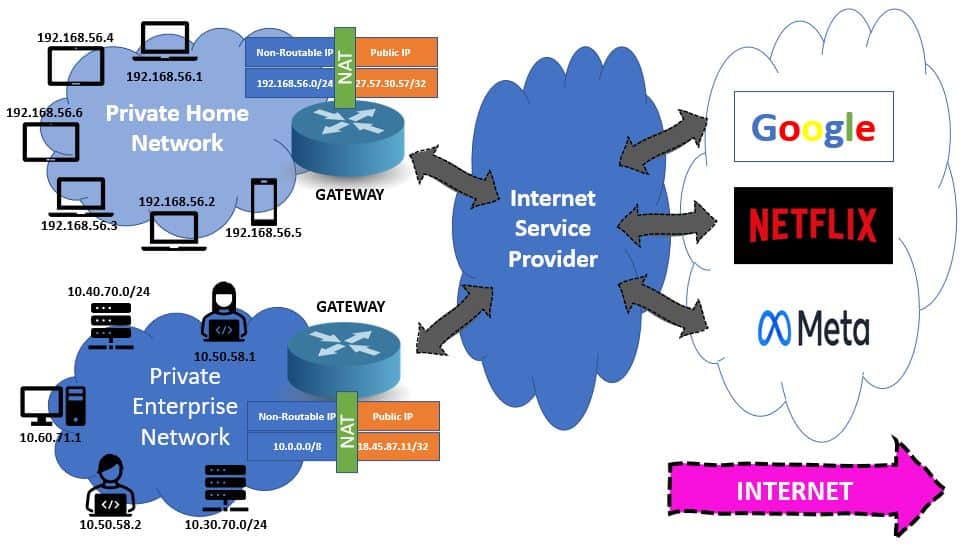1. 概述
作为网络工程师或系统管理员,在设计网络架构或排查问题时,经常会接触到“公网IP”和“不可路由IP地址”这类术语。这些地址构成了我们如今所依赖的复杂网络结构的基石。
本文将围绕几个关键点展开:
- 为什么使用不可路由IP地址
- NAT(网络地址转换)如何帮助扩展IPv4网络
- 它在IPv6过渡中所起的辅助作用
2. 什么是IP地址
在现实生活中,人们通过姓名识别彼此。在计算机网络中,设备通过IP地址进行识别和通信。
每台连接到网络的设备都必须拥有一个唯一的IP地址,才能与其他设备通信。目前,互联网之所以存在,正是因为这种唯一的地址机制。
IP地址主要由IANA(Internet Assigned Numbers Authority)管理分配,目前主流的IP版本有两种:
- IPv4:32位地址,采用点分十进制表示(如
192.168.1.1) - IPv6:128位地址,采用冒号分隔的十六进制表示(如
2001:db8::1)
3. 公网IP与私网IP
IPv4地址分为两类:
- 公网IP(Public IP):全球唯一,可通过互联网直接访问,通常由ISP分配,使用BGP路由协议在全球范围内传播。
- 私网IP(Private IP):也称为不可路由IP地址(Non-routable IP Address),这些地址不会在互联网上传播,主要用于构建局域网内部通信。
私网IP地址的优点是帮助企业或家庭构建本地网络,无需暴露给公网。但缺点是私网维护和故障排查相对复杂。
4. 不可路由IP地址详解
随着互联网用户数量的爆炸式增长,IPv4地址资源日益紧张。虽然IPv6提供了几乎无限的地址空间,但由于种种现实原因,全面迁移到IPv6仍需时间。
为缓解IPv4地址枯竭问题,RFC 1918 在1996年定义了私有地址范围,用于构建局域网内部通信。以下是RFC 1918中定义的三段私网IP地址范围:
| 地址段 | 范围 | 可用IP数 |
|---|---|---|
10.0.0.0/8 |
10.0.0.0 - 10.255.255.255 | 16,777,214 |
172.16.0.0/12 |
172.16.0.0 - 172.31.255.255 | 1,048,574 |
192.168.0.0/16 |
192.168.0.0 - 192.168.255.255 | 65,534 |
这些地址可以在局域网内自由使用,但不能直接在互联网上通信,必须通过NAT技术进行地址转换。
5. 网络地址转换(NAT)
随着家庭和企业网络的普及,IPv4地址的消耗速度加快。虽然IPv6是未来的方向,但在短期内全面替换IPv4并不现实。
NAT(Network Address Translation) 作为缓解IPv4地址枯竭的重要手段,应运而生。它工作在OSI模型的第三层(网络层),通常部署在路由器上。
NAT的作用是:
✅ 将私网中的多个设备映射为一个公网IP地址
✅ 隐藏内部网络结构,增强安全性
✅ 节省公网IP资源
例如,一个家庭局域网可能有多个设备(如手机、电脑、智能电视等),它们都使用 192.168.1.x 的私网地址,而通过NAT后,对外只显示一个公网IP地址。
6. 互联网通信流程解析
互联网本质上是由无数个网络连接组成的全球性网络。数据通信依赖于IP协议和数据包的传输机制。
数据包结构
一个典型的数据包包含以下信息:
- 源IP地址
- 目的IP地址
- 源端口
- 目的端口
- 数据内容
示例:私网设备访问互联网
下图展示了家庭和企业网络访问互联网时的典型流程:

- 家庭网络使用
192.168.56.0/24段,设备获取私网IP。 - 所有流量汇聚到网关(路由器)。
- 路由器上的NAT将私网IP转换为公网IP(如
27.57.30.57)。 - 当流量到达Google服务器时,识别到源IP为
27.57.30.57,而非私网地址。 - 企业网络同理,使用
10.0.0.0/8段,通过NAT转换为公网IP18.45.87.11。 - 最终,公网只看到一个IP地址,而隐藏了背后的整个私网结构。
这种机制带来的好处是:
- ✅ 有效节省公网IP资源
- ✅ 提高网络安全性
- ✅ 简化网络管理
举个例子:一个家庭网络中有254个私网地址,只需一个公网IP就能访问互联网;企业网络中甚至可以用一个公网IP管理上百万个私网地址!
7. 总结
不可路由IP地址(即私网IP)是为局域网通信而设计的,它们不会在互联网上直接路由。这类地址的引入,是为了解决IPv4地址枯竭问题。
虽然IPv6是未来的发展方向,但全面迁移仍需时间。在此过渡阶段,NAT + 私网IP 提供了一种有效的临时解决方案,不仅节省了公网IP资源,还增强了网络安全性。
✅ 关键点总结:
- 不可路由IP地址主要用于局域网内部通信
- RFC 1918定义了三类私网地址范围
- NAT技术实现了私网到公网的地址转换
- NAT显著节省公网IP资源并提升安全性
- 过渡期中,NAT是IPv4与IPv6共存的重要桥梁
如果你在实际工作中遇到IP地址规划、NAT配置或网络隔离相关问题,理解这些概念将有助于你更好地排查和设计网络架构。